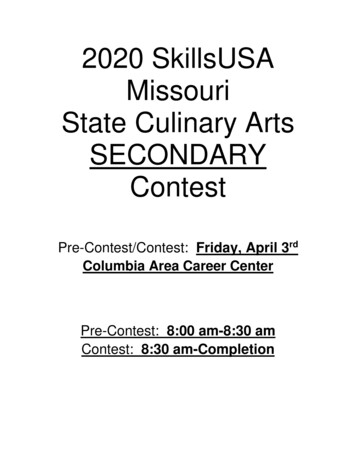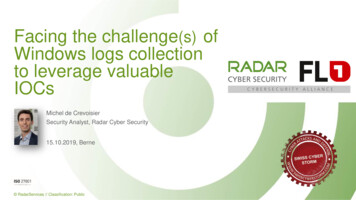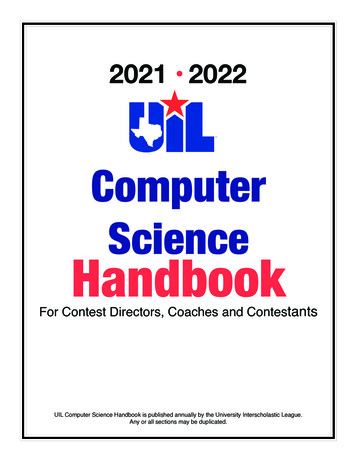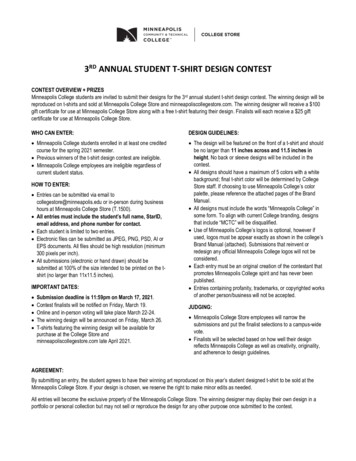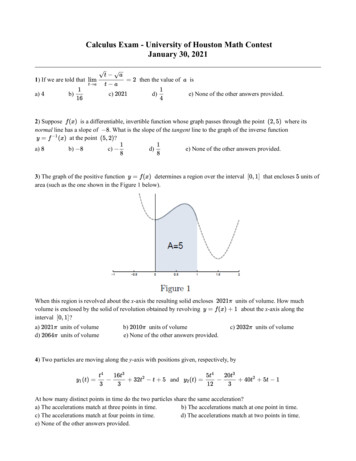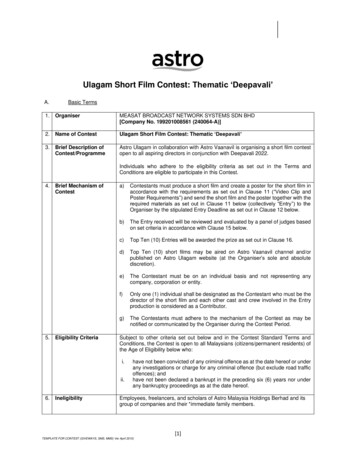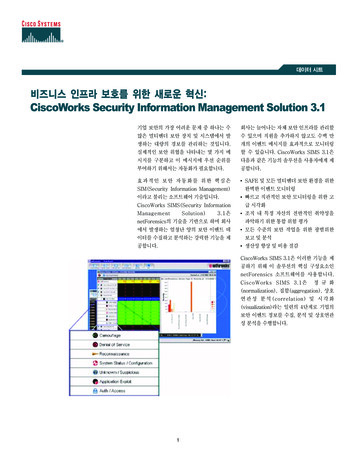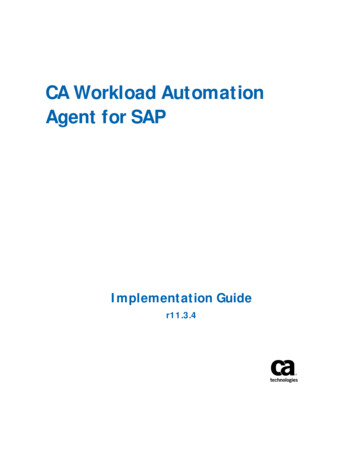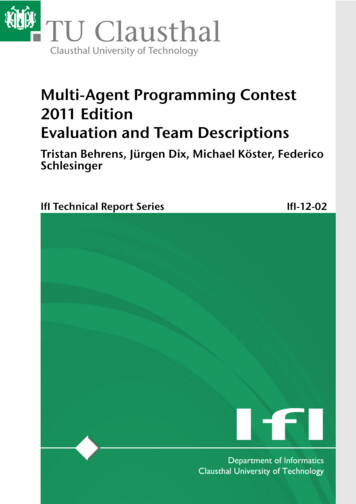
Transcription
Multi-Agent Programming Contest2011 EditionEvaluation and Team DescriptionsTristan Behrens, Jürgen Dix, Michael Köster, FedericoSchlesingerIfI Technical Report SeriesIfI-12-02
ImpressumPublisher: Institut für Informatik, Technische Universität ClausthalJulius-Albert Str. 4, 38678 Clausthal-Zellerfeld, GermanyEditor of the series: Jürgen DixTechnical editor: Federico SchlesingerContact: federico.schlesinger@tu-clausthal.deURL: reports/ISSN: 1860-8477The IfI Review BoardProf. Dr. Jürgen Dix (Theoretical Computer Science/Computational Intelligence)Prof. i.R. Dr. Klaus Ecker (Applied Computer Science)Prof. Dr. Sven Hartmann (Databases and Information Systems)Prof. i.R. Dr. Gerhard R. Joubert (Practical Computer Science)apl. Prof. Dr. Günter Kemnitz (Hardware and Robotics)Prof. i.R. Dr. Ingbert Kupka (Theoretical Computer Science)Prof. i.R. Dr. Wilfried Lex (Mathematical Foundations of Computer Science)Prof. Dr. Jörg Müller (Business Information Technology)Prof. Dr. Niels Pinkwart (Business Information Technology)Prof. Dr. Andreas Rausch (Software Systems Engineering)apl. Prof. Dr. Matthias Reuter (Modeling and Simulation)Prof. Dr. Harald Richter (Technical Informatics and Computer Systems)Prof. Dr. Gabriel Zachmann (Computer Graphics)Prof. Dr. Christian Siemers (Embedded Systems)PD. Dr. habil. Wojciech Jamroga (Theoretical Computer Science)Dr. Michaela Huhn (Theoretical Foundations of Computer Science)
Multi-Agent Programming Contest2011 EditionEvaluation and Team DescriptionsTristan Behrens, Jürgen Dix, Michael Köster, Federico SchlesingerAbstractThe Multi-Agent Programming Contest is an annual competition in agentbased artificial intelligence. The year 2011 marked the beginning of a newphase with the introduction of the Agents-on-Mars-scenario. The focuswas shifted towards heterogeneous multi-agent systems with both competitive and cooperative agent interaction. On top of that, new means forevaluating the performance of individual agents and whole agent teamswere designed and established. In this document we will provide a systematic, statistical evaluation of the 2011 tournament. In a second partwe will also present in-depth descriptions of the participating teams.Part IContest Evaluation1IntroductionIn this Technical Report, we give a comprehensive evaluation of the resultsof the Multi-Agent Programming Contest1 2011 edition. The Contest is anannual international event that started in 2005. In 2011 the competitionwas organized and held for the seventh time. The Contest is an attempt tostimulate research in the field of programming multi-agent system by1. identifying key problems,2. collecting suitable benchmarks, and3. gathering test cases which require and enforce coordinated action thatcan serve as milestones for testing multi-agent programming languages,platforms and tools.1 http://multi-agentcontest.org1
The Multi-Agent Programming ContestResearch communities benefit from competitions that (1) attempt to evaluate different aspects of the systems under consideration, (2) allow for comparing state of the art systems, (3) act as a driver and catalyst for developments, and (4) define challenging research problems.In this report we extend the work presented in [Behrens et al., 2012b], byfocusing on the outcomes of the Contest. The document is organized as follows: We firstly mention some related work in Section 2, and then brieflydescribe the Contest in section 2. In Section 4 a short description of each ofthe participating teams is provided. Section 5 presents the main contributions of this paper, with an in-depth analysis of the results of the Contest.Finally we present a conclusion and future work in section 6.Part II of this document presents the in-depth team descriptions providedby team developers themselves. These descriptions follow a template provided by the Multi-Agent Programming Contest organization (a requirementfor the participation).2Related WorkThe Multi-Agent Programming Contest has generated several publications inthe recent years [Dastani et al., 2005, Dastani et al., 2006b, Dastani et al., 2008a,Dastani et al., 2008b, Behrens et al., 2009, Behrens et al., 2010]. Similar contests, competitions and challenges are Google’s AI challenge2 , the AI-MAS Winter Olympics3 , the Starcraft AI Competition4 , the Mario AI Championship5 , theORTS competition6 , and the Planning Competition7 . All these competition aredefined in their own research niches. Our Contest has been designed forproblem solving approaches that are based on formal approaches and computational logics, thus distinguishing it from the other competitions.3The Multi-Agent Programming ContestThe Multi-Agent Programming Contest was initiated in 2005 and since thenwent through three distinct phases. The first phase began in 2005 with the“food-gatherers”-scenario, where a pre-specified multi-agent system had tobe implemented. These MASs were later examined in order to determine thewinner. From 2006 - 2007 the “goldminers”-scenario was used. This time it2 http://aichallenge.org/3 http://www.aiolympics.ro/4 http://eis.ucsc.edu/StarCraftAICompetition5 http://www.marioai.org/6 http://skatgame.net/mburo/orts/7 http://ipc.icaps-conference.org/DEPARTMENT OF INFORMATICS2
MAPC 2011 EVALUATION AND TEAM DESCRIPTIONSis provided an environment by means of an online-architecture, and automatically determined the winner. Then from 2008 - 2010 we ran the “cowsand cowboys”-scenario, again on the same online-architecture.We noticed that most approaches used in the agent contest in the lastyears were centralized, contrary to the philosophy of multi-agent programming (MAP). Even the accumulated knowledge of the agents was maintainedcentrally and shared by internal communication. This aspect has motivatedthe definition of a new scenario, which is described next.3.1The 2011 ScenarioIn this year’s Contest (for a detailed description see [Behrens et al., 2012a])the participants have to compete in an environment that is constituted bya graph where the vertices have an unique identifier and also a number thatdetermines the value of that vertex. The weights of the edges on the otherhand denotes the costs of traversing the edge.A zone is a subgraph (with at least two nodes) whose vertices are colored bya specific graph coloring algorithm. If the vertices of a zone are colored witha certain team color it is said that this team occupies this area. The value of azone is determined by the sum of its vertices’ values. Since the agents do notknow a priori the values of the vertices, only probed vertices contribute withtheir full value to the zone-value, unprobed ones only contribute one point.The goal of the game is to maximize the score. The score is computed bysumming up the values of the zones and the current money for each simulation step:stepsXscore (zoness moneys )s 1Here steps is the number of simulation steps, and zoness and moneys arethe current sum of all zone values and the current amount of money respectively.Figure 1 shows such a scenario. The numbers depicted in the vertices describe the values of the water wells while the distance of two water wells islabeled with travel costs. The green team controls the green zone while theblue team has the smaller blue zone. The value of the blue zone, assumingthat all vertices have been probed by the blue team, is 24.4Brief Team-DescriptionsA total of nine teams from all around the world took part in the 2011 editionof the tournament (see Table 1). In the following, a brief description of eachof those teams is given. The full descriptions provided by the teams themselves can be found in part II of this document.3Technical Report IfI-12-02
Brief Team-DescriptionsFigure 1: A screenshot.The d3lp0r team from Universidad Nacional del Sur, Argentina, was implemented to show that argumentation via defeasible logic programming canbe applied in a multi-agent gaming situation. It has been implemented using Python, Prolog and DeLP. The solution is a decentralized architecture,where each agent runs as an individual process and percepts are shared viaa broadcasting mechanism with a minimal complexity. This coordinationmechanism is facilitated by a perception server that gathers and distributesall relevant percepts. Decision making takes place on an individual agentlevel and has no centralized characteristics. The team’s main strategy is todetect profitable zones based on the data collected about explored verticesand position the agents correctly to maintain, defend and expand the zones.The HactarV2 team from TU Delft, Netherlands, was implemented usingthe GOAL agent-oriented programming language with Prolog as the knowledge representation language. The team follows a decentralized strategy based on an implicit coordination mechanism, where agents predict the ac-DEPARTMENT OF INFORMATICS4
MAPC 2011 EVALUATION AND TEAM iversidad Nacional del Sur, ArgentinaTU Delft, NetherlandsUniversität Göttingen, GermanyArak University, IranTechnical University of DenmarkArak University, IranArak University, IranTU Berlin, GermanyUniversity College Dublin, nJava/JADEJACKJIAC VAgentFactoryTable 1: Participants overview.tions that other agents perform and base their own choice of actions on thatprediction. The agents share all data about the map and opponents witheach other, while neither using a centralized information store nor a central coordination manager. The team’s main strategy is to firstly computethe zone with the highest value and secondly building and maintaining aswarm of agents around the node with the highest value.HempelsSofa8 has been developed at Göttingen University. The team isbased on a solution that has been implemented during a course on multiagent programming, held at Clausthal University of Technology. The agentswere developed in Java using a simplified architecture that allows for an explicit mental state and inter-agent communication. All agents are executedin a single process and each agent has access to a shared world model that isupdated every time and agent perceives something.Python-DTU from Technical University of Denmark is based on an auctionbased agreement approach and has been implemented in Python. The solution is decentralized, allowing agents to share percepts through shared datastructures and coordinate their actions via distributed algorithms. Agentsshare all new percepts in order to keep the agents’ internal world modelsidentical. In the first ten percent of each simulation the team explores themap and inspects the opponents. After that, a valuable zone is conqueredand maintained while letting saboteurs attack and repairers repair. Valuablezone detection is facilitated by firstly selecting the most valuable known vertex and then focusing on vertices around the selected one. Communicationand coordination involves placing bids on different goals and then executing an auction-based agreement algorithm.Team Nargel from Arak University, Iran, is a true multi-agent system developed using Java for agent behaviors and JADE for agent communication. Theperformance of the agents was on a level that did not require any distribution8 The team HempelsSofa took part in the Contest out of competition.5Technical Report IfI-12-02
Contest Organization and Resultsof agents on different machines. The team strategy is based on the intentto conquer zones, while also disturbing the opponent’s ones. The disturbing behavior is more successful than the zone making strategy. Agents sharetheir acquired knowledge by means of inter-agent communication only andthus do not have a centralized pool if information. On top of that, intentions are also on an individual agent level, thus resulting in a decentralizedcoordination approach.The Simurgh team, also from Arak University, made use of Java as an agentimplementation language, while using the Gaia methodology for analysisand design. The team uses a decentralized coordination and cooperationmechanism, in which agents share their percepts via a shared communication channel. Agents autonomously generate goals based on their knowledge. Goals in conflict are resolved. Each agent is executed in its own threadand has its own world model. The agents are divided into three groups. Thezone holders are responsible for creating and maintaining zones using a scattering algorithm. The world explorers intent to complete their world modelquickly. And the repairers strive to repair disabled agents as soon as possible.Sorena is the third team from Arak University. The developers used thePrometheus methodology for the system specification and the JACK agentplatform for actually implementing and executing the agents.The TUB team comes from Berlin Technical University. The team’s development has been done by roughly following the JIAC methodology. Theteam is completely decentralized, while each agent is perfectly capable ofperforming each role. Usually one agent is responsible for zoning and agentsposition themselves on the map using a simple voting protocol. Agents shareall their percepts, which, although having a high complexity, worked perfectly for the small team. The team makes use of both implicit and explicitcoordination. Implicit coordination is considered to be achieved by sharingintentions. Explicit coordination, however, is only used for the collaboration of inspectors and saboteurs. From the beginning each agent follows itsown achievement collections strategy. The zone score on the other hand islocally optimized by letting agents move to the next node that improves thezone.The UCDBogtrotters team from University College Dublin, Ireland, has beenimplemented using the AF-TeleoReactive and AF-AgentSpeak multi-agent programming languages running on the AgentFactory platform. The overallteam strategy involves a leader agent, which assigns tasks to other agents,and platform services for information sharing. Finding zones is facilitatedby a simple clustering algorithm. The team combines a set of role dependentstrategies and the overall zone creation strategy.DEPARTMENT OF INFORMATICS6
MAPC 2011 EVALUATION AND TEAM 83: 1,459,391: 2,185,634: 2,219,281: 2,366,805: 3,821,088: 9Points72605745361815156Table 2: Final Ranking.55.1Contest Organization and ResultsTournament OrganizationThe rules of the tournament indicated that every team had to compete ina match against each of the other eight teams. The winner of the tournament was the team that earned the most tournament-points in total (as opposed to in-simulation points). Matches consisted of 3 independent simulations, played in randomly generated maps of 3 different predefined sizes.Tournament-points were awarded in a per-simulation basis: winning a simulation was worth 3 tournament points, whereas no points where given tothe losing team. In the unlikely event of a tie, both teams would be given 1point.The tournament took place from 5th to 9th of September 2011. For eachday of the contest, the teams where divided in 3 groups of 3 teams, andplayed against each other within the group. Each group was assigned to a different server, so matches from different groups were held in parallel. Groupswhere resorted every day to make sure every combination was covered andevery team played against each other exactly once.5.2Tournament ResultsThe four days of competition allowed team HactarV2 to stand out as the clearwinner, after defeating their opponents in every single simulation they tookplace in. Team Python-DTU achieved a distinguished second place, being theteam that collected the biggest simulation-score sum throughout the tournament. A close third was TUB, only 3 points below. The complete finalranking is depicted in Table 2.We present the result of each simulation of each match in Section 5.3.Matches are presented in chronological order; this is relevant to some of theresults because some teams experienced bugs and connection problems thatwere not detected in the two-week connection-testing period before the tournament, and which in most cases were corrected during the competition.7Technical Report IfI-12-02
Contest Organization and ResultsFurther information in this regard is given in Section 5.4, which is also concerned with the agent teams’ quality and stability. Next, in Section 5.5, weanalyze simulations individually to a deeper extend by looking at the evolution and composition of the score. Finally, in Section 5.6, we observe howactions were selected by each role of each team, and relate this numbers tothat team’s strategy.5.3Simulation ResultsPythonDTU vs. TUB84,82462,58882,07865,27766,03268,509MatchSim 1Sim 2Sim 3MatchSim 1Sim 2Sim 3MatchSim 1Sim 2Sim 3HempelsS. vs. TUB5,953131,2153,140119,4458,84699,295UCD vs. sS. vs. r vs. gh vs. Nargel43,73929,36113,38041,8489,40466,468Sorena vs. Nargel35,39323,93838,27033,40037,60323,786d3lp0r vs. UCD16,546142,0913,170280,481264370,728Sorena vs. Simurgh41,61757,24553,60337,21551,24652,054Table 3: Matches Day 1.MatchSim 1Sim 2Sim 3MatchSim 1Sim 2Sim 3MatchSim 1Sim 2Sim 3TUB Nargel22,46233,08626,849HactarV2 vs. Nargel103,52923,335105,90827,73290,83428,605vs. Sorena44,33145,74545,757Python-DTU vs. Simurgh109,95937,986229,4565,060103,8941,243d3lp0r vs. Sorena93,36252,70353,85259,86177,68769,807UCD vs. rV260,00161,20361,787vs. TUB44,85045,19447,857d3lp0r vs. HempelsS.49,34491,27629,21185,86948,55686,796UCD vs. ble 4: Matches Day 2.DEPARTMENT OF INFORMATICS8
MAPC 2011 EVALUATION AND TEAM DESCRIPTIONSTUB vs. im 1Sim 2Sim 3MatchSim 1Sim 2Sim 3MatchSim 1Sim 2Sim 3HempelsS.96,55877,14276,768vs. Nargel16,63826,69639,299Sorena vs. p0r vs. Simurgh32,16773,71646,29179,09464,02072,134UCD DTU vs. r4,4614,23219,301vs. TUB401,122336,559169,868UCD vs. a vs. e 5: Matches Day 3.MatchSim 1Sim 2Sim 3UCD Sim 1Sim 2Sim 3Simurgh vs. im 1Sim 2Sim 3Python-DTU131,224104,71397,123vs. Nargel23,66120,86943,897Sorena vs. TUB31,773133,15723,482 148,22318,949137,617HempS. vs. HactarV258,13487,06331,16799,57546,96087,607d3lp0r vs. Nargel99,67652,09492,53055,81057,88027,711UCD vs. TUB51,27867,73028,96274,95772,23275,701HempS. vs. Simurgh66,33047,88163,31838,99854,33444,004d3lp0r vs. le 6: Matches Day 4.9Technical Report IfI-12-02
Contest Organization and Results5.4Teams’ Quality and StabilityIn order to analyze the quality and stability of the teams – and to a certainextent also the stability of the platforms – we summed up the number of actions sent by an agent in time (i.e., in two seconds) and the actions that faileddue to lack of time. The results are shown in Table 7. Since each team hadthe opportunity to test the network connection (and especially the networkbandwidth) two weeks before in some test matches, these results cannot onlygive us some hints regarding the overall performance but also some indications concerning the quality and stability of each agent team. Togetherwith the experiments we made throughout the Contest, i.e., checking thenetwork ping and bandwidth, we can conclude the empelsSofaSimurghSorenad3lp0rNargelDay 10,67%0%0,03%39,51%8,10%41,14%1,85%29,42%6,24%Day y 30%0%0,11%1,55%0,08%12,63%0,55%16,79%0,91%Day 05%0,38%11,79%3,20%24,82%2,34%15,02%2,18%Table 7: Actions not sent in time.The first three teams HactarV2, Python-DTU and TUB did not have anyproblems sending actions in the two second time interval. Their networkconnection was good, but more important – as the Contest results (Tab. 2)show - their agents were able to process the percepts sent by our server andto provide an useful answer in time.The UCDBogtrotters had some problems (a bug in the code of the agents)on the first day. After fixing it the agents were sometimes still too slow. Additionally, the explorer agents as well as the inspector agents tried to executethe parry-action which was not allowed for these rules. For this reason weargue that the stability was quite okay but the code quality was not perfect.HempelsSofa had a serious bug at day one and the team performed verybadly. The bug was not detected in an early phase, because the wrong credentials were used for testing. Afterwards the response time was good. Thus,the quality and stability was okay, but the testing routines failed.The Iranian teams Simurgh, Nargel and Sorena faced some network bandwidth problems in the test matches. However, they improved there codeand/or used some computers from different countries for the real Contest.Nevertheless they did not perform well. The results of Simurgh – especiallyDEPARTMENT OF INFORMATICS10
MAPC 2011 EVALUATION AND TEAM DESCRIPTIONSwhen taking into account that they were only sending 60 percent of actionsin time for the first two days – were still okay but the code had some major flaws: The explorers and inspectors tried to execute the parry-action whichwas not allowed for these rules. The stability and code quality of Nargel andSorena can be classified as medium since on day 1 respectively day 2 the teamshad some connection problems.d3lp0r finally implemented the communication protocol between the server and the agent teams in a wrong way. Their agents were not able to attackother agents if the name of the opponent was starting with an upper caseletter. Aside, only at the very last day they were able to send enough actionsin time. Thus we infer that both, the code quality as well as the stability waslow. The results attest this claim as well.5.5Analysis of Individual MatchesIn order to further analyze the performance of teams and the effectivenessof the strategies applied, we now analyze some selected simulations in moredetail. In order to improve comparability we will focus only on the mid-sizemap simulations, which in most cases is also representative of the final result of the match. We present graphs that show the evolution of the currentscore throughout a simulation, distinguishing zones-score and achievementpoints. This graphs give already by themselves a handful of information, andsometimes directly reflect aspects of the different strategies applied. Nevertheless, it is interesting in some cases to go further and study some particularsituations of the simulations that can ultimately help in explaining thesegraphs.5.5.1HactarV2 vs. PythonDTUThe match between HactarV2 vs. PythonDTU (Figure 2) was a decisive one,as it faced the two teams that ended up being the winner and the runnerup of the contest. PythonDTU started the simulation well, collecting morepoints than HactarV2 during the first steps, both in terms of zones-score andachievement points. The big difference in terms of achievement points atthis stage was mainly because of HactarV2’s more aggressive buying strategy,which seems to have paid off as both teams achievement points stabilizedtowards the end.Around step 90, as both teams had explored an adequate portion of themap and focused on conquering the most valuable nodes at the center ofthe map, a particular situation arose, that remained until the end of thematch and gave a huge advantage to HactarV2: Gathered on a single nodewhere PythonDTU’s repairers and HactarV2’s saboteurs, among some extraagents. HactarV2’s saboteurs were made strong enough (via the buy action)11Technical Report IfI-12-02
Contest Organization and ResultsFigure 2: HactarV2 vs. PythonDTU.so that they could disable opponent agents with a single hit. A cycle beganin which HactarV2’s saboteurs would alternate attacking (and instantly disabling) each of the opponent repairers. Since they were not recharging at thesame time, they could ensure that on every step at least one of them wouldbe attacking. Python’s repairers contributed to this cycle with their behavior: on every step the enabled repairer would repair the disable one, but alsoreceive an attack and become disabled for the next step. Then, on the nextstep the choice of action for the just disabled repaired would be to rechargewhile waiting to be repaired, enabling this vicious circle to continue almostindefinitely. Figure 3 shows a particular step during this cycle.The node where all this took place was one of the high-valued ones, soit remained most of the time in HactarV2’s domination, although some sporadic incursions from other PythonDTU’s agents changed that for a few steps.The two saboteurs of PythonDTU where disabled just before the above-mentionedcycle started, and of course were not repaired, so they did not represent athreat anymore. The rest of HactarV2 team could focus on maintaining arather big, stable zone, which explains the big difference in the final score.5.5.2HactarV2 vs. SimurghFigure 4 shows that the simulation of HactarV2 vs. Simurgh began with aclear domination of the zone-score from HactarV2 team. Several battles tookplace right from the beginning, and many of the Simurgh’s agents becameprematurely disabled as result. Both teams attempted to improve their sabo-DEPARTMENT OF INFORMATICS12
MAPC 2011 EVALUATION AND TEAM DESCRIPTIONSFigure 3: HactarV2 vs. PythonDTU screenshot.teurs with the early achievement-points obtained, but Simurgh’s saboteursprioritized the buy action over attacking, even when sharing location withother saboteurs; they often got attacked and the buy attempt failed. Afterthe first steps, the many disabled agents from Simurgh tended to regroupthemselves with the repairers, but HactarV2’s saboteurs remained close andkept those agents busy most of the simulation. The Simurgh agents couldnot handle the situation well, with the repairers repairing with no apparentrole-based priority, and the saboteurs often skipping actions or attemptingbuys instead of attacking. The rest of the agents from HactarV2 managedto build and maintain a valuable zone in the center of the map, which ensured the team the big difference in the final score. The fewer free agentsfrom Simurgh, on the other hand, could build some smaller zones towardsthe borders of the maps through the simulation, but these would only earnthe team very few points.5.5.3HactarV2 vs. UCDBogtrottersUCDBogtrotters suffered a lot of connection problems during the first day ofcompetition (aproximately 40 percent of the actions were not sent in time tothe server. See Subsection 5.4) and that is clearly reflected in Figure 5. HactarV2 was presented with almost no resistance from their opponents, andtook advantage of it gathering several points. The peaks in the graph around13Technical Report IfI-12-02
Contest Organization and ResultsFigure 4: HactarV2 vs. Simurgh.steps 100, 300, and 700 correspond to moments during the simulation inwhich all agents from UCDBogtrotters were disabled, thus giving HactarV2domination of the entire map.DEPARTMENT OF INFORMATICS14
MAPC 2011 EVALUATION AND TEAM DESCRIPTIONSFigure 5: HactarV2 vs. UCDBogtrotters.15Technical Report IfI-12-02
Contest Organization and Results5.5.4HempelsSofa vs. UCDBogtrottersFigure 6: HempelsSofa vs. UCDBogtrotters.Figure 6 shows an interesting simulation between HempelsSofa and UCDBogtrotters, with clear domination of the latter. During the initial phase itappears as if both teams were able to locate the most valuable nodes at thecenter of the map, and towards step 66 they both tried to build zones there.Figure 7 shows however a big difference between those zones: UCDBogtrotters’ expands in more nodes, while HempelsSofa team tend to gather moreagents in fewer nodes, resulting in a very small zone, that is even less worthybecause of unprobed nodes.Later during the simulation, around step 100, UCDBogtrotters managedto conquer the center of the map. HempelsSofa agents started alternatingbetween moving in zone-formation around the center (with rather low zonescores), and engaging in battle in the center, not very successfully. A coupleof times during the simulation, the only few agents from HempelsSofa stillenabled move around the center and become surrounded by agents fromUCDBogtrotters, as shown in Figure 8, where UCDBogtrotters gain domination of almost the complete map, except for this few nodes in the center.DEPARTMENT OF INFORMATICS16
MAPC 2011 EVALUATION AND TEAM DESCRIPTIONSFigure 7: HempelsSofa vs. UCDBogtrotters screenshot.17Technical Report IfI-12-02
Contest Organization and ResultsFigure 8: HempelsSofa vs. UCDBogtrotters screenshot.DEPARTMENT OF INFORMATICS18
MAPC 2011 EVALUATION AND TEAM DESCRIPTIONS5.5.5PythonDTU vs. UCDBogtrottersFigure 9: PythonDTU vs. UCDBogtrotters.At the beginning of the match, that is in the first 50 steps, UCD seems togroup most of the agents together on few nodes. This approach makes it easier for to be attacked, and less efficient when it comes to exploring the map,because they probed less
Prof. Dr. Jürgen Dix (Theoretical Computer Science/Computational Intelligence) Prof. i.R. Dr. Klaus Ecker (Applied Computer Science) Prof. Dr. Sven Hartmann (Databases and Information Systems) Prof. i.R. Dr. Gerhard R. Joubert (Practical Computer Science) apl. Prof. Dr. Günter Kemnitz (Hardware and Robotics)
